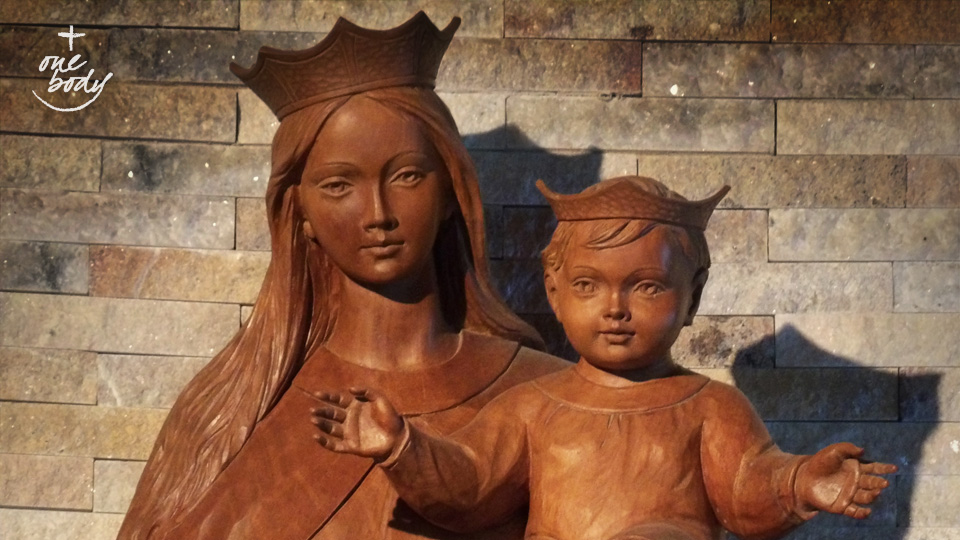

Mary, Help of Christian Unity? | One Body
Julien Hammond
Tuesday, May 30, 2023

María Auxiliadora. Photo by Emiliano Arruabarrena SDB on Cathopic.

Mary, Help of Christian Unity?
by Julien Hammond
About twenty years ago, I read some astonishing words from Pope John Paul II about the promise of the Rosary for advancing Christian unity:Perhaps there are some who fear that the Rosary is somehow unecumenical because of its distinctly Marian character. Yet the Rosary clearly belongs to the kind of veneration of the Mother of God described by the [Second Vatican] Council: a devotion directed to the Christological centre of the Christian faith, in such a way that "when the Mother is honoured, the Son ... is duly known, loved and glorified." (Lumen Gentium #66) If properly revitalized, the Rosary is an aid and certainly not a hindrance to ecumenism! (Rosarium Virginis Mariae, #4)The Holy Father’s words troubled me then, as they do now. In my lived experience, Marian…“anything” in an ecumenical context is far more likely to present differences over similarities, or even harden well-defined perspectives, than prompt ideas about growing together in Christian love. No one is neutral, it seems, when it comes to describing their relationship to the Mother of God. At the root of Christian agreements and disagreements about Mary are matters that are at the same time biblical, doctrinal, historical, liturgical, theological, sociological, soteriological, ecclesiological, and so on. What does the Bible say or not say about Mary, and how is this to be interpreted? How much of what is professed about Mary belongs to the Tradition of the Church rather than directly found in Scripture? How much is from historical, cultural, or sentimental expressions developed within specific churches? Does Marian doctrine or devotion enhance or take away anything from the central focus on Christ? What is the relationship between God’s grace present and active in Mary’s life, and her own (and our own) human actions or belief? What is meant by the veneration of Mary (or of the saints) as distinct from worshipping God? When and by whose authority did Marian titles, feasts, and dogmas come to be assigned within the Christian Church? Are all such titles, feasts, and dogmas essential, obligatory, and/or intended to be marked with equal solemnity? How is Mary’s life and faith presented as a model for female Christian discipleship, or as exemplary for Christian life in general? Such questions (and this is by no means an exhaustive list) touch upon the foundations of the Christian faith, and form the very fabric of denominational identities. As these questions come to be posed, interpreted, and answered, it becomes clear why discussions about Mary are never neutral: they open up everything else, and become necessarily important as a reflection and manifestation of the “what” and “how” of basic Christian belief. What, then, is the future of Mary, ecumenically-speaking? Is she forever destined to be the “Mother of Christian Disunity”? It is encouraging to note that considerable progress is being made through international and national ecumenical dialogue groups, and by numerous theologians from across the Christian spectrum, toward a common understanding of the role of Mary in salvation history. Here are some highlights:
Evangelicals
In 1984, the Evangelical-Roman Catholic Dialogue on Mission (ERCDOM) took up a dialogue on Mary in response to Pope Paul VI’s Apostolic Exhortation Marialis Cultus (1974). Evangelicals in the dialogue sought mainly to clarify certain Catholic terms used to describe Mary, such as “Mother of God,” “Mediatrix,” and “worthy Associate of the Redeemer.” Their Report states that “The fears of Evangelicals were to some extent allayed by these Roman Catholic explanations and assurances. Yet a certain Evangelical uneasiness remained. The vocabulary used [by Roman Catholics] in relation to Mary seemed to them certainly ambiguous and probably misleading. Is it not vitally important, they asked, especially in the central doctrine of salvation through Christ alone, to avoid expressions which require elaborate explanation (however much hallowed by long tradition) and to confine ourselves to language with is plainly and unequivocally Christ-centred?” For Catholics, such terms help to express and to nuance the “place given by God to Mary in salvation history and in the life of the Church.” The two groups remain in dialogue on these perspectives.Groupe des Dombes
Throughout the 1990’s, the (unofficial) international Catholic-Protestant dialogue group, Le Groupe des Dombes, undertook an intensive study of Mary. They published it in French under the title, Marie dans le dessein de Dieu et la communion des saints, (Bayard Editions/Le Centurion, 1999), and in English translation as Mary in the Plan of God and in the Communion of the Saints. (Paulist Press, 2002) This remarkable work is presented in two parts: Part 1 is a history of the development of Marian doctrine, and a re-examination of the Scriptural testimony and discernment of the early ecumenical councils that enshrined Marian devotion into the creeds of the early Church. Part 2 is an examination of disputed questions: the “Cooperation” of Mary in Salvation, the relationship between Grace and Freedom, the Perpetual Virginity of Mary, and the Catholic dogmas of the Immaculate Conception and the Assumption. The Groupe called for a renewal of attitudes, a conversion among both Catholics and Protestants, especially where “Mary was isolated from both Christ and the communion of saints and when devotion to her took on exaggerated forms.” (Mary in the Plan of God, 114). Their conclusion: “At the end of our historical, biblical and doctrinal study we do not find any irreducible incompatibilities, despite some real theological and practical divergences.” (129) This is a remarkable study, and an ecumenical development that deserves to be better known.Anglicans
In 2005, the Anglican-Roman Catholic International Commission (ARCIC) published Mary: Grace and Hope in Christ. This in-depth report examines Mary according to the Scriptures, in the Christian Tradition, in the economy of Grace, and in the life of the Church. It “deepens and extends” a number of agreements reached previously in Anglican-Roman Catholic dialogue statements (especially Authority in the Church II, #30), and encourages Anglicans and Catholics to carefully follow the guidance of Sacred Scripture concerning any remaining areas of disagreement. (Cf. Grace and Hope in Christ #77) Poignantly, the two churches “agree that doctrines and devotions which are contrary to Scripture cannot be said to be revealed by God nor to be the teaching of the Church,” and as these focus on Mary they must be “carefully expressed [by] norms which ensure the unique and central place of Jesus Christ in the life of the Church.” (#79) The text offers – within a footnote (!) – that “the explicit acceptance of the precise wording of the definitions of 1854 [the Immaculate Conception] and 1950 [the Assumption] might not be required of believers who were not in communion with Rome when they were defined. Conversely, Anglicans would have to accept that the definitions are a legitimate expression of Catholic faith, and are to be respected as such, even if these formulations were not employed by them.” (#63, fn 13) It justifies this by considering other instances of ecumenical agreement, such as the Common Christological Declaration between the Catholic Church and the Assyrian Church of the East (1994) and the Joint Declaration on the Doctrine of Justification between the Roman Catholic Church and the Lutheran World Federation (1999). According to Grace and Hope in Christ, those examples offered the possibility that “what one [dialogue] partner has defined as de fide [of the faith] can be expressed by another partner in a different way.” With all these caveats and provisions, ARCIC concludes its report with the significant and hopeful affirmation that “it points to the possibility of further reconciliation, in which issues concerning doctrine and devotion to Mary need no longer be seen as communion-dividing, or an obstacle in a new stage of growth into visible koinonia.” (#80) Interested readers will want to check out the Canadian response to Mary: Grace and Hope in Christ, released by the members of the Anglican-Roman Catholic Dialogue of Canada in October 2008.Methodists
The Methodist-Roman Catholic International Commission (MERCIC) included some significant reflections on Mary within their 2016 report, The Call to Holiness: From Glory to Glory. Picking up many of the same themes, especially Mary in the Scriptures and the development of doctrine/dogma concerning Mary, the Methodist-Catholic dialogue offers an extended reflection on Marian devotion. “Whereas Methodists have no tradition of Marian devotion, Catholics have a significant tradition of devotions relating to the Mother of Our Lord: Marian prayers and anthems, praying the rosary, feast days, processions, and pilgrimages to sites of Marian apparitions.” (#127) Does Marian devotion, specifically an appeal to the intercession of Mary, “show a lack of confidence in Jesus Christ,” or does it fulfill the words recorded in the Magnificat: “Surely, from now on all generations will call me blessed” (Luke 1.48, cf. Call to Holiness #164)? “Continuing joint reflection on these questions will lead to greater mutual understanding and, hopefully, to greater convergence between Catholics and Methodists about Mary, the Mother of the Lord, as a sign of grace and holiness.” (#164) These are but a few examples of the extraordinary dialogue work on Mary taking place in ecumenical circles today. More could be found, of course, in the dialogues with Orthodox, Lutheran, and other partners, in ecumenical monastic settings, among movements and associations with particular Marian emphases (for example, Focolare and the Ecumenical Society of the Blessed Virgin Mary), and even at some classic sites of Marian pilgrimage, such as Walsingham and Lourdes. All of this points to a reality neatly summarized by Cardinal Walter Kasper in A Handbook of Spiritual Ecumenism (2007): “Mary also accompanies the Church’s journey toward Christian unity.” (#23) For this reason, she remains a figure of significant interest, if not importance, for many Christians in their daily walk with Christ. Julien Hammond has been the ecumenical officer for the Catholic Archdiocese of Edmonton for over twenty years. He has served as a member of the Roman Catholic-United Church of Canada Dialogue, the Anglican-Roman Catholic Dialogue in Canada, and the Christian Church (Disciples of Christ)-Roman Catholic International Consultation. He is currently a member of the Jewish-Catholic national dialogue, co-sponsored by the Canadian Rabbinic Caucus and the Canadian Conference of Catholic Bishops.
Julien Hammond has been the ecumenical officer for the Catholic Archdiocese of Edmonton for over twenty years. He has served as a member of the Roman Catholic-United Church of Canada Dialogue, the Anglican-Roman Catholic Dialogue in Canada, and the Christian Church (Disciples of Christ)-Roman Catholic International Consultation. He is currently a member of the Jewish-Catholic national dialogue, co-sponsored by the Canadian Rabbinic Caucus and the Canadian Conference of Catholic Bishops.Related Articles:
<<













